Most people in the western world are grossed out by the idea of eating bugs at the present time. But a growing voice is trying to change that and make it the norm.
Can you set your squeamishness aside to pursue insect farming as a sustainable and profitable business?
In this article, you’ll learn what insect farming is, what kinds of insects are commonly farmed, the benefits and drawbacks, and how to start farming crickets so you can give insect farming a try for yourself. Plus I’ll share some examples of real insect farms that are operating today.
By the end of this article, I hope to convince you that farming bugs is a practical way to diversify your farm’s income and that they can be just as rewarding as growing crops or breeding livestock.
What Is Insect Farming?
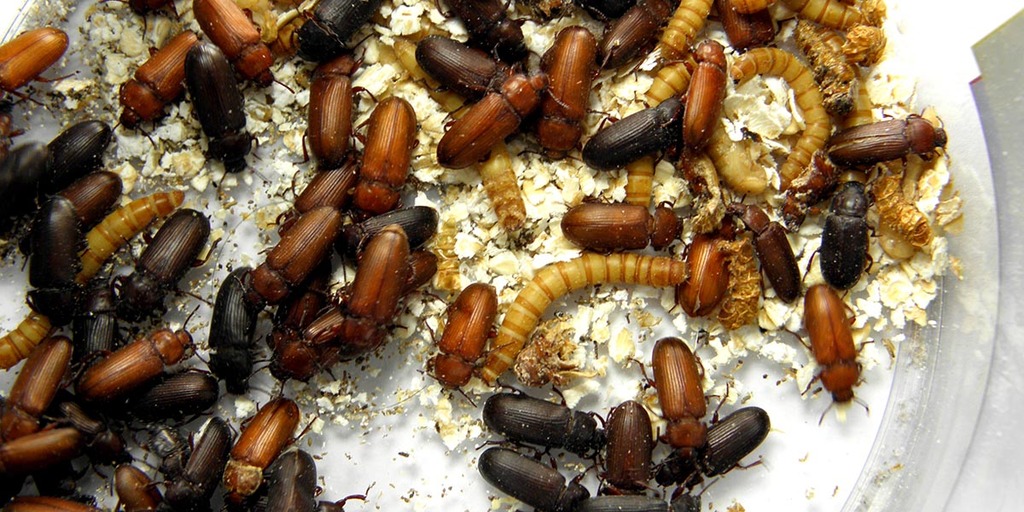
Insect farming includes all processes involved with producing commodities from bugs, including raising and breeding them.
They are basically livestock, although kept in much higher numbers than the amount of cows or pigs that you could keep on a small farm.
There are a bunch of different insects that are farmed for a wide variety of purposes. Some of them are used as food for humans, others are used as food for other animals.
Others make valuable products like silk, while others are used for making dye.
In the West, we have a stigma around eating and keeping bugs that doesn’t exist in many other areas in the world.
Much in the same way that things like eating organ meat have largely fallen out of favor with most people today. But even in Europe and North America, it hasn’t always been this way.
Insects of various kinds represent a great business opportunity for farmers, as well as a sustainable way to help the environment and cut down on the carbon footprint of other types of farming.
- If you want to add more to your farm, check these 21 Of The Best Small Scale Farming Ideas.
- Also, read more in my guide How To Set Up A Low Tech Mushroom Farm at home.
Insects That Are Commonly Farmed
There are a wide variety of insects that are farmed for a variety of purposes all around the world. Including in North America and the UK at an increasing rate.
Although insects are still an unusual crop for farming, I really believe that it could well be the next big trend.
Now is the time to think about getting yourself established as a knowledgable insect farmer while we’re still on the cutting edge.
1. Honeybees
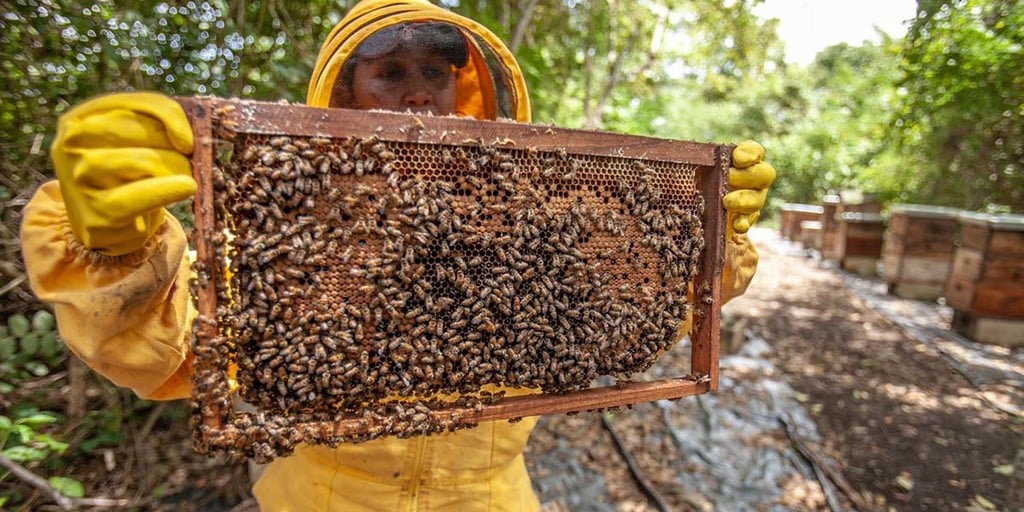
When most people think of farming insects, it seems very strange and unusual. But farming honeybees is already quite normalized and most people wouldn’t blink an eye if you told them that you’re a beekeeper.
So I’ve chosen to start off this list with the most normalized insect that you can keep.
Most of us grew up eating honey, so it’s very normalized for us.
But imagine trying to convince someone who has never eaten honey before how good it is, while also explaining to them that it’s something that’s been regurgitated by an insect.
Out of context, you’d expect to get some very odd looks.
Hopefully, this puts things into perspective and makes you more open-minded to trying new insect-based products. Or perhaps I’ve just made you swear off eating honey forever, for which I apologize.
The truth is that honeybees are good for producing a lot more than just honey. There’s bee pollen, bee bread (fermented bee pollen), royal jelly (a food and dietary supplement), propolis (a resin that can be used as a natural wood finish), and beeswax (can be used to make candles and many other products.)
You can even raise broods of bees to sell them to other beekeepers.
You’ve probably heard in the news about how the populations of wild bees have decreased significantly in recent years as well. This is leading to issues with crop pollenation for some farmers.
You can even make a business of renting your beehives out to farms, allowing them to pollinate crops for a few weeks before moving them on to the next farm.
Farmers will basically pay you to let them feed your bees and help them make honey for you!
2. Cochineal Beetles

Cochineal Beetles are reddish insects whose shells are ground up to make a vibrant red dye.
This dye is used in a wide variety of products, including many that you probably use without even realizing it. Including things like cosmetics, paint, fabric, and even food.
If you have any reddish food, check the label. If it contains these beetles, they’ll either show up on the ingredient list as cochineal, carmine dye, E120, or Natural Red 4.
Again, apologies for ruining your favorite yogurt, juice, and candy by pointing out that you’ve already been eating bugs for your entire life without knowing it.
Cochineal beetles have a particular affinity for prickly pear cacti, so the two are often farmed together. It takes about 100,000 of the beetles to make one kilogram of dye.
3. Cockroaches

Of all the insects on my list, I imagine this one will elicit the most visceral reaction from people. Our society has programmed us to believe that cockroaches are an infestation that must be eradicated.
If you find out that cockroaches are living in your house, you’re likely to call in an exterminator and do everything possible to wipe them out completely.
So you’d have to be crazy to try and intentionally breed cockroaches, right?
Well, maybe not. Cockroaches are huge in China, where they’re farmed by the millions. In other places they’ve been growing in popularity for the past decade or so as well.
Apparently they’re actually much cleaner and tastier than their reputation would lead you to believe. People who have tried them say they have the texture and taste of a greasy piece of chicken.
Considering the reputation cockroaches have for being prodigious breeders and nearly impossible to kill, it seems like a pretty foolproof farm venture. Just don’t let them get loose!
4. Silkworms
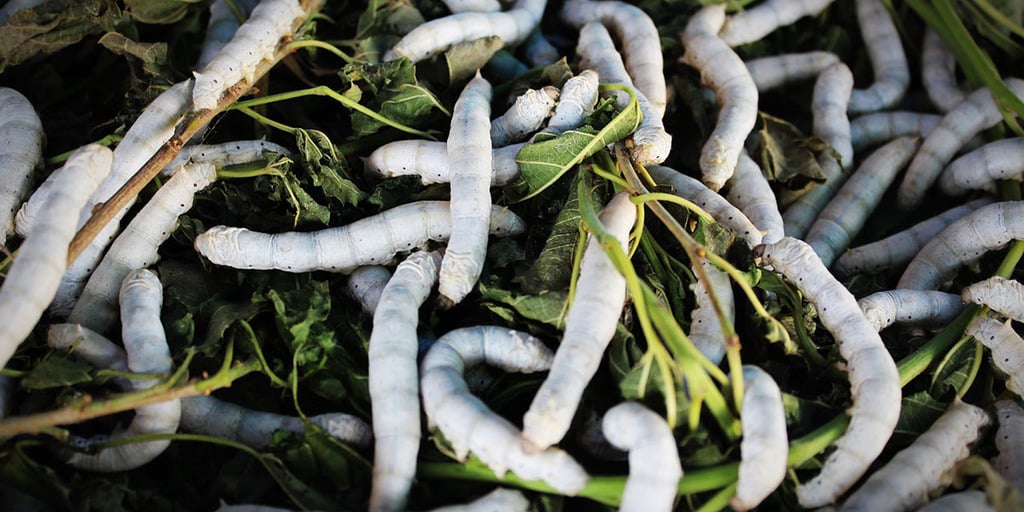
Silkworms aren’t actually worms at all, they’re actually the domesticated caterpillars of a type of silkmoth.
Most people are familiar with silk, a luxurious fiber used to make bedsheets and many other textile products. This silk comes from the cocoon of silkworms.
Silk is a very profitable cash crop, although it may be more complicated to produce and process than some other items on this list.
5. Waxworms, Mealworms, and Buffaloworms
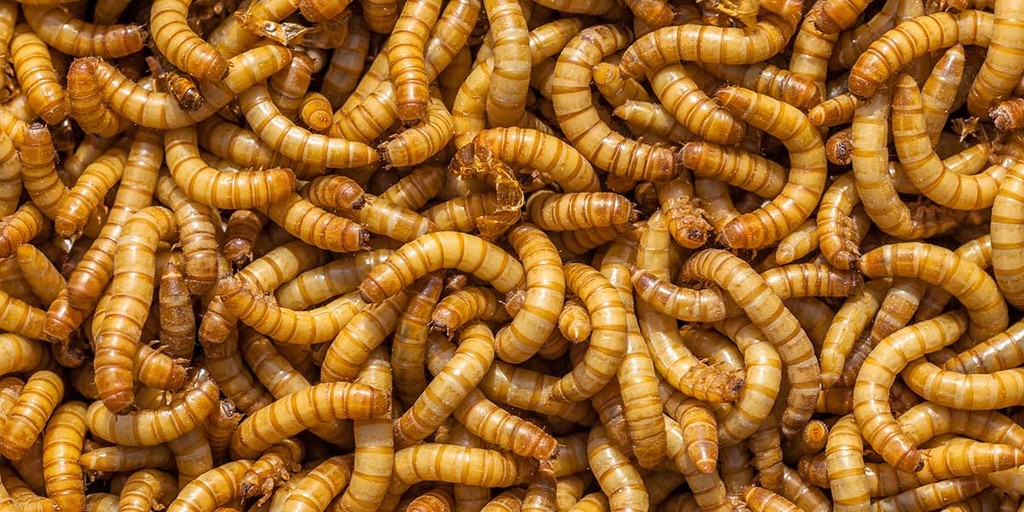
All of these insects are farmed individually and are a whole product unto themselves. But for the sake of simplicity, I’ll combine them into one category here.
These insects have a wide variety of uses for human food, feeding pets, fish bait, animal testing, and even to break down plastic products.
They are high in fat content but low in protein, and make a great food source for lizards and other pets that need to eat live insects.
Like cockroaches, these insects are easy to produce and can live in a fairly wide variety of environments.
6. Lac Insects
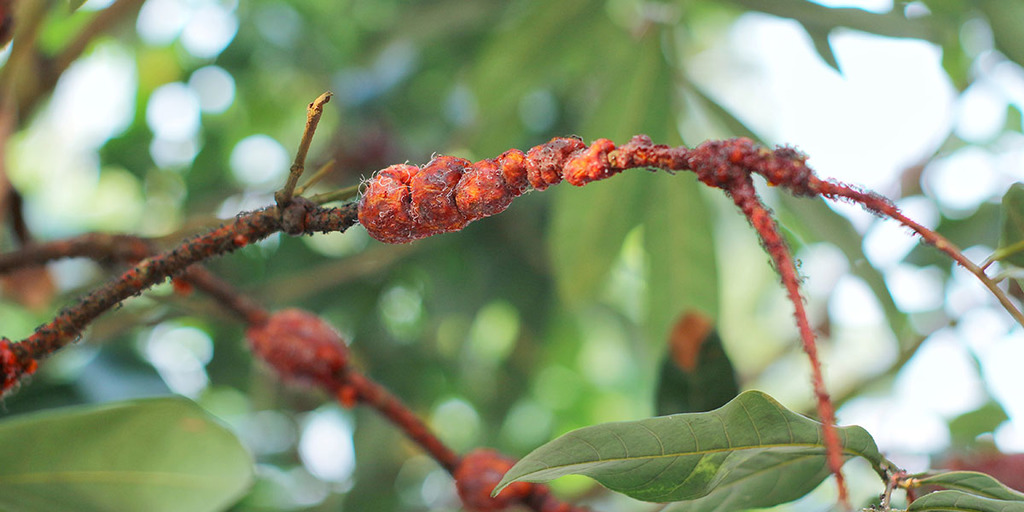
Lac insects produce a substance called lac that acts as a resin. Lac has many purposes and can be used for everything from wood finish to nail polish to food colorant.
Other words for lac include shellac or lacquer. Currently, most lac farming is done in Thailand and India.
7. Crickets
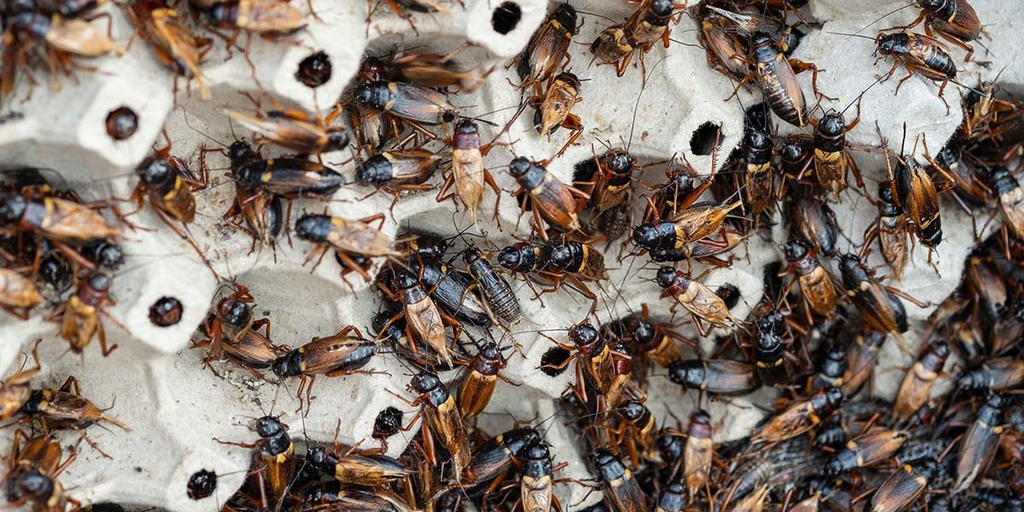
Of all the insects that are currently farmed, crickets seem the most promising in terms of widespread adoption for human consumption.
There are hundreds of different species of crickets, but it’s the house cricket that’s most commonly farmed today.
Crickets contain some of the best nutrition profile of any edible insect. And there is a wide variety of different ways that you can prepare them for eating.
They can be deep-fried, boiled, dry roasted, baked, or even dried and ground into cricket flour, which is protein-rich and can be incorporated into a wide variety of dishes.
Crickets are also widely farmed as food for non-animals as well, and you can find them in most pet stores. They’re used to feed birds, reptiles, mammals, and even larger fish of various kinds.
If you’re worried about the ethics of harvesting crickets, they’re normally frozen and supposedly don’t feel any pain during the process.
Starting Your First Insect Farm – How To Breed Crickets
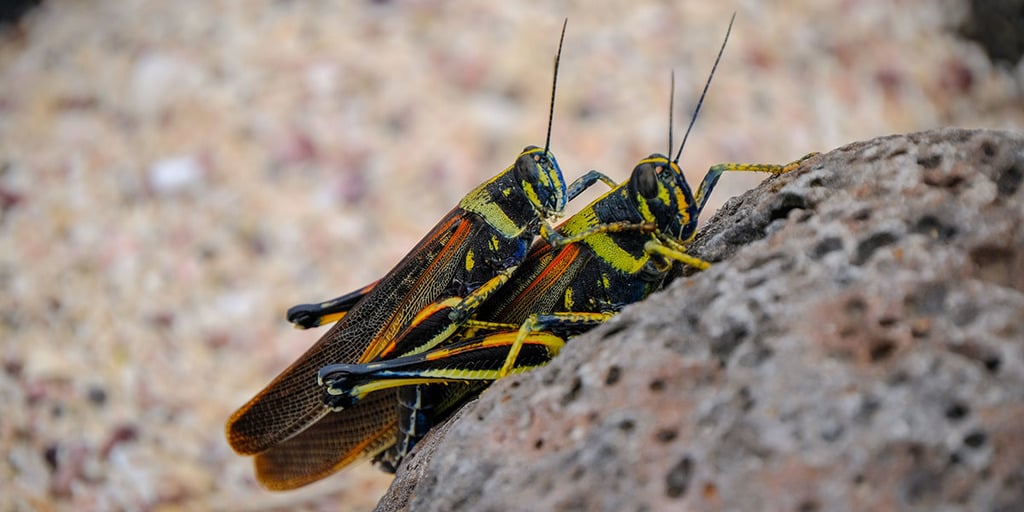
Crickets are an easy beginner choice for farmers who are looking to get in to raising insects for the first time.
Raising crickets on a large commercial scale has some challenges. But if you just want to get started on a small scale, you can start earning some profit from crickets right away.
It’s the #1 insect I’d recommend for anyone who wants to give it a try.
Right now, live crickets sell for anywhere between $15 and $50 per 1,000 crickets in bulk, depending on who you’re selling them to.
If you’ve got pets of your own who require them, breeding your own crickets can help to save money. If you have chickens they would love to get some extra bugs in their diet.
Or if not, you can try to sell them as a side-business to other people for bait and feed. The best part is that you can get started for under $200.
1) Getting Set Up

Crickets aren’t too fussy. All they really need is some food, water, and shelter. And to be kept at the right temperature and humidity ideally as well.
You can make a cricket breeding container from a large plastic bin and some aluminum window screening. Just cut off half the lid and glue the window screening on the area you removed.
Then place some empty egg cartons inside the container so your crickets have a place to hide.
Inside your main container, you’ll want to put a medium-sized food container with a lid, like a margarine tub, and a smaller food container. Each container needs to have a hole cut out so the crickets can get inside.
The purpose of these containers is to create environments with higher humidity levels than the main container itself.
The smallest container will be where crickets will lay their eggs, and the medium-sized container will be where they rear their young.
The smaller containers should be filled with coconut coir to act as a bedding and kept moist at all times.
Over top of the screening on your container, you’ll want to put a 150 watt heat lamp. The container should be kept between 29 – 32 C (85 – 90 F.) Try not to let your crickets get below 27 C (80F) or above 35 C (95 F.)
Now your container is all set up and you can buy some crickets to get started with. Be sure that you get a mix of males and females. They are quite easy to tell apart.
Female crickets will have a needle-like appendage at the back that male crickets lack. They use this when they’re laying eggs.
2) Feeding Your Crickets
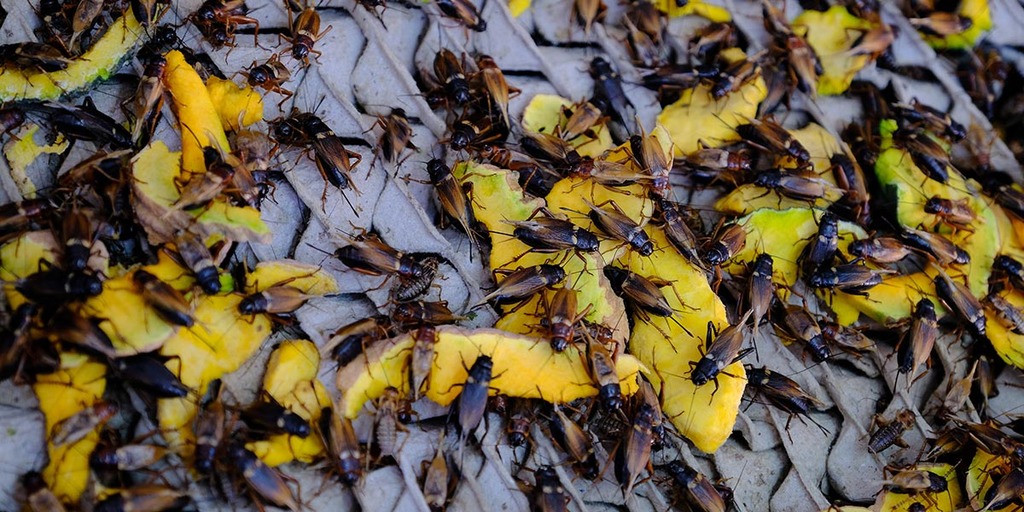
Your crickets need to have access to food and water at all times. Otherwise they will start to cannibalize each other, which isn’t a pretty sight.
You don’t want to simply set out a dish of water or you risk your crickets drowning. Instead, soak up water in a sponge or clean piece of cloth and then set it on a plastic lid.
You’ll want to change this cloth out every 3 or 4 days so bacteria and other nasty microorganisms don’t start to build up.
Your crickets will be happy to eat pretty much whatever kitchen scraps you can give to them. They’ll eat leafy greens, vegetables, fruits, and even leftover meat.
It’s actually advisable to try and give your crickets a source of protein. The more variation they have in their diet, the healthier they’re likely to be.
3) Maintaining Your Cricket Farm

Every week, you’ll want to give your cricket container a good cleaning. To make this really easy, I’d recommend having a second plastic bin and extra small containers.
Then you can just transfer the whole thing over without much trouble, and alternate between the two sets of containers each week.
After one or two weeks, you’ll start to notice baby crickets hatching.
4) Selling Your Crickets
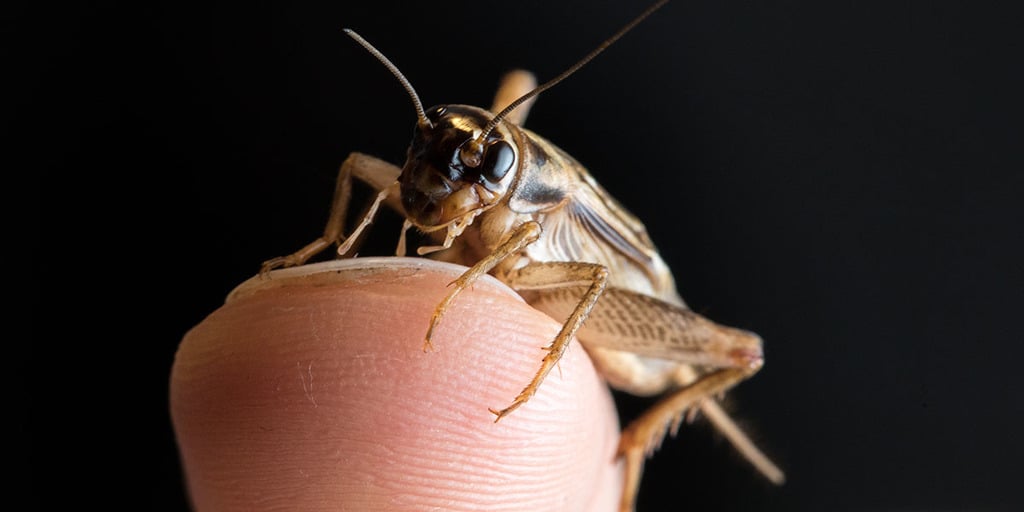
Once your cricket colony is starting to grow, you’ll need a way to begin selling the excess.
A good place to start is by asking all the local pet stores in your area if they would like to buy some of your crickets.
Pet stores are quite used to working with and being approached by local animal breeders, so it won’t be out of the ordinary for them.
Many will be glad to have a local supplier that might be able to offer better quality, healthier crickets for a lower price than larger suppliers.
Get creative and use social media to find groups of people in your city that might be interested in buying your crickets. This can include people who own reptiles, birds, exotic fish, and other pets who eat insects.
It’s worth setting up a page for your business on Facebook and other social media as well. It’s free, and it’s good advertising.
Once you exhaust all of your local customers, if you’re still looking to sell more crickets, then you can start tapping into a larger online audience. This comes with its own challenges.
You’ll need to figure out how to ship live crickets and ensure they arrive alive. But there are many websites that are successfully selling crickets, mealworms, and other insects already.
What Are The Benefits of Farming Insects?
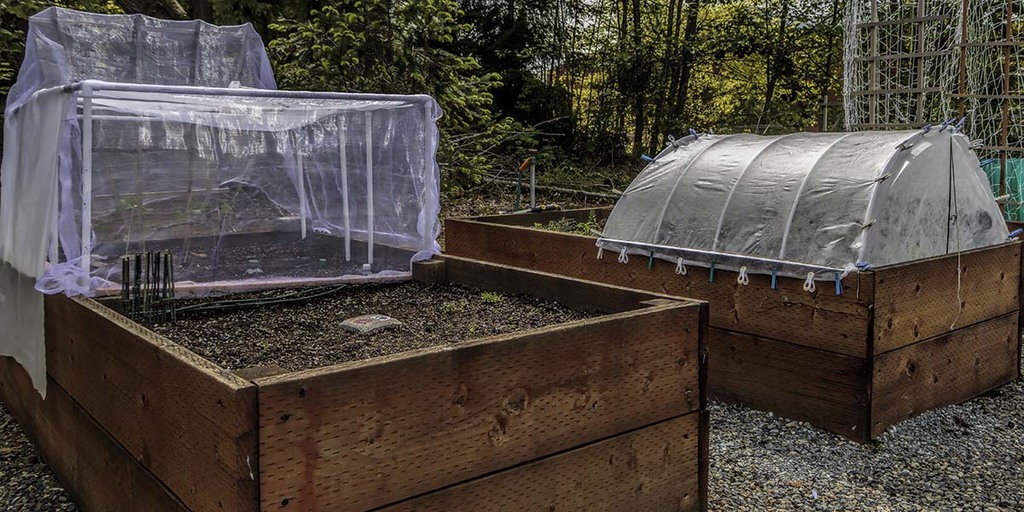
Raising and eating insects has a number of benefits that both farmers and end consumers can take advantage of.
1. Insects Take Up Less Land and Other Resources
In terms of agricultural land use, raising livestock currently accounts for 70%. The need for grazing land leads to the destruction of natural ecosystems, and displaces wildlife as well as potentially humans as well.
Overgrazing of livestock can do a lot of damage to the land. Insects take up significantly less space than conventional livestock like pigs, cows, sheep, and even chickens do.
They also produce less waste and require less resources, pound for pound, than raising mammals and birds.
2. Insects Offer Better Nutrient Efficiency
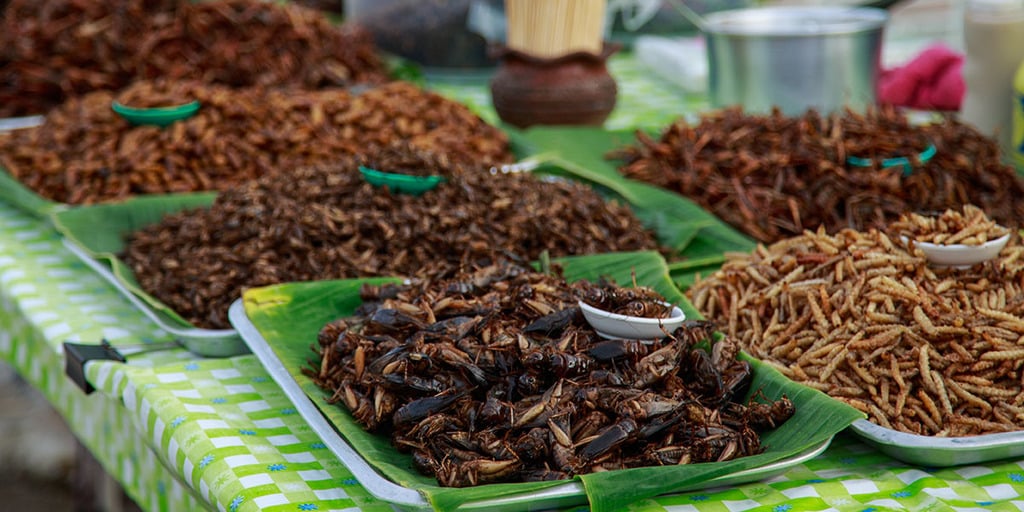
Insect protein content is efficient and quite comparable compared to other types of meat like pork or beef.
In fact, the protein count in 100 grams of crickets is about the same as in 100 grams of lean ground beef. Beef also contains about three times as many calories and four times as much fat, making crickets a much more nutrient-dense food.
The fatty acids in insects are also comparable to those in fish. They contain high amounts of polyunsaturated fatty acids.
Fat content in insects largely depends on their diet, their habitat, and at what stage of their life cycle they’re in.
So like with any type of food, you really need to do your due diligence and be sure you’re buying insects that are raised in optimal conditions to maximize nutrient content.
One area where insects lag behind beef and other types of meat is iron content. Although high levels of iron have also been associated with things like heart disease, so perhaps that’s not such a bad thing.
Insects also contain dietary fiber, which can’t be found in other types of meat.
Insects also cost a lot less to care for and produce. It takes about 2 kilograms of feed to produce 1 kilogram of edible insects.
Chickens require about two times that much, and cows need about twelve times as much feed.
Lastly, all parts of edible insects are used, meaning nothing goes to waste.
With beef, pork, and chicken, there are parts of the animal that aren’t available for human consumption and are wasted.
3. Insects Cause Less Greenhouse Gas Emissions
When it comes to farming and greenhouse gas emissions, things often get reduced down to the “cow flatulence causes climate change” discussion.
But it’s true that raising livestock is responsible for about 18% of all greenhouse gases, since they produce methane and ammonia as byproducts in large amounts.
Insects and other alternative protein sources have negligible emissions when it comes to greenhouse gases. Aside from termites, no farmed insect species produce methane as a byproduct, and none of them make ammonia.
Insects don’t separate their metabolic wastes (urine in animals) and their digestive waste (excrement.)
4. Insects Grow and Reproduce Faster
As a general rule, the larger and more complex an animal is, the longer its life cycle and breeding cycle is. Insects mature more quickly than just about any other animal or crop that you can grow on a farm.
Crickets are fully grown in under a month, and one female cricket can lay more than a thousand eggs during that time period.
In comparison, cattle take two years to become adults, and it takes four breeding animals for every market animal that gets produced.
Like I mentioned earlier, it takes 12 times as much feed to produce the same amount of protein in cattle as in crickets.
A big part of this is because crickets get their heat from the external environment, instead of having to create their own body heat like mammals do.
5. Insects Carry Less Disease Risk
It seems like every year, there’s another epidemic or outbreak that leads to the recall of millions of pounds of beef, pork, or chicken.
Edible insects can’t carry or transmit many of the serious health conditions that conventional farm animals can, like salmonella, H1N1, or mad cow disease.
Since insects are so far removed from humans compared to other mammals, the chances of any future disease transmission is much lower as well.
Even if we drastically increase our production of edible insects to match that of other kinds of meat.
6. Insects Can Increase Food Security
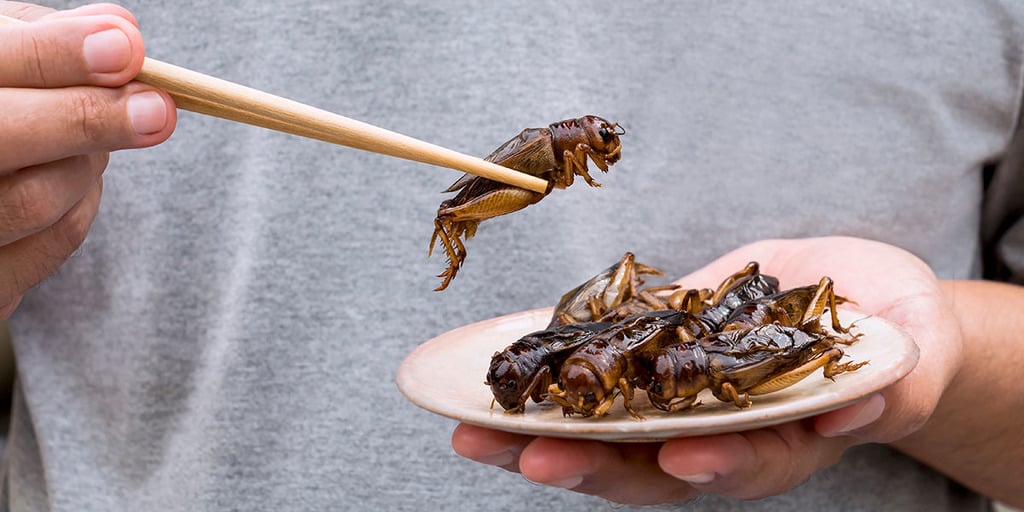
Insects are a readily available source of carbohydrates, fats, proteins, vitamins, and minerals.
They are a great opportunity especially in less wealthy nations to produce necessary food while also helping to preserve the environment.
Farming insects can help alleviate pressure from climate change, food shortages, and lack of land availability.
The cost of meat is rising, and feed is becoming more expensive and harder to get. Combined with increasing populations throughout Africa and Asia, there is demand for a more cost-effective source of food.
Many people who live in these regions can’t afford the infrastructure or upfront cost of raising cows, chickens, or other livestock.
But insects represent the opportunity for a very low-cost startup and require very little space compared to conventional livestock.
In Thailand alone, there are around 20,000 cricket farms which produce about 7,500 tonnes of food each year.
Especially in such warm and humid climates where native bugs are naturally large, there are ecological, economic, and nutritional advantages to raising indigenous insect species.
7. Farming Insects Can Help With Pests
Farms that grow crops can become overrun with insects that cause damage and reduce income. But instead of using harmful pesticides, these insects can be caught and used as a food source.
Grasshoppers are a good example in North America and Europe, while the sago palm weevil is a serious pest to coconut, oil, and date palms in Asia.
Some scientists propose we solve our pest problem by capturing insects and using them as food.
Removing the need for pesticides, combined with the additional revenue from selling insects, could potentially net farmers a few extra thousand dollars per year.
8. Insects Cause Less Water Pollution
Manure runoff from livestock farms is a serious concern for our drinking water, and a major cause of water pollution. When livestock is farmed in coastal areas, it can create “dead zones” and damage coral reefs.
It also causes any number of human health problems, can contribute to the rise of antibiotic resistant bacteria, and other problems.
In addition to animal waste, the hormones and antibiotics used to raise the animals, as well as chemicals used in things like leather tanning can also leech into the water.
If that’s not bad enough, livestock also compact soil, making it less effective at filtration.
Raising crops isn’t without its own issues, as sediment, fertilizers, and pesticides in runoff water can cause problems of its own.
Disadvantages of Farming Insects
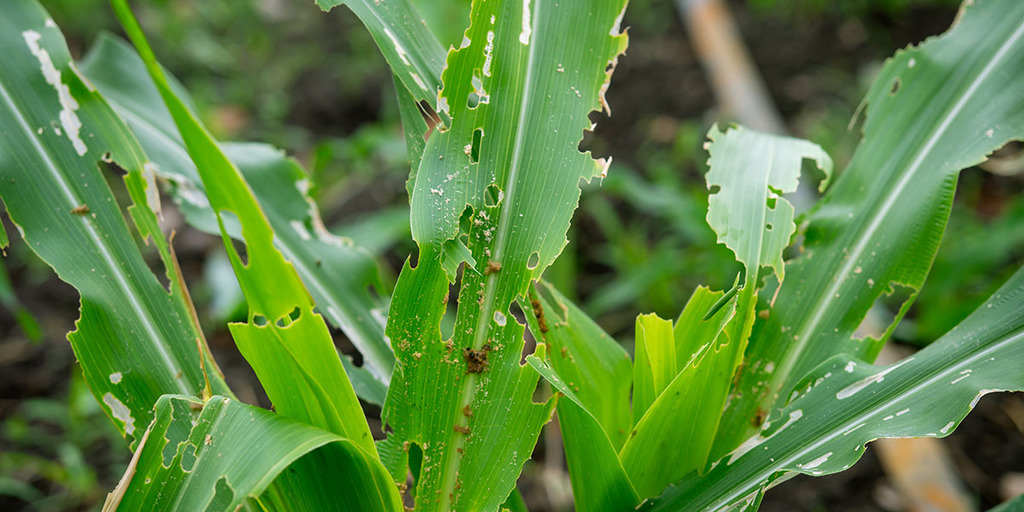
While insects offer many great advantages over other types of farming, there are of course some disadvantages and risks too.
1. Toxicity
Insects can eat plants that are toxic or poisonous to humans. In turn, when we eat insects, we can get a dose of the toxic chemicals from these plants if the insect had eaten them recently.
This is less of an issue for farmed insects, since their diet is carefully controlled. But it’s a risk associated with harvesting wild insects that could be considered.
You wouldn’t want to eat vegetables that were grown on the side of the road where they absorb pollution from cars all day.
Similarly, you probably don’t want to eat insects that have lived their lives in the city where they’ve been exposed to all kinds of chemicals and pollution, such as pesticides and insecticides on people’s lawns.
There have been documented cases of lead poisoning as a result of eating contaminated grasshoppers.
So if you are going to harvest your own insects from the wild, be mindful of where they are coming from and what they may have been exposed to.
Chemicals tend to accumulate in insects through the process of bioaccumulation.
Parasites are also common in some types of insects, so it’s always advised to cook any insects before eating them.
2. Spoilage
Insects are more prone to being affected by mold, fungi, and spore-forming bacteria. This can affect both raw and cooked insects if they aren’t handled appropriately.
Farms need to take special care and precautions when handling insects to avoid spoilage. Insects should be boiled prior to refrigeration, and drying is best to prevent problems associated with moisture.
How Farms Process Insects
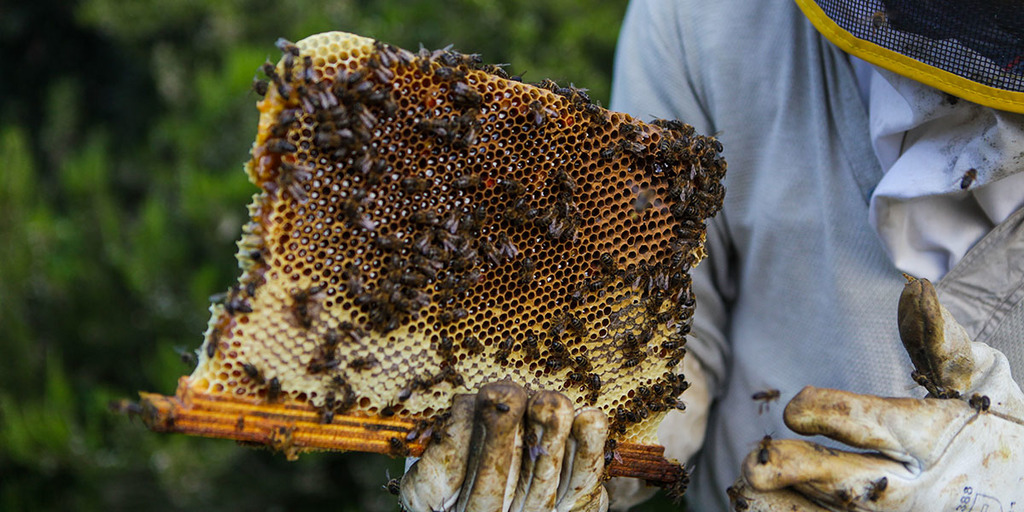
Although insects are considered less sentient and intelligent than mammals like cows and pigs, they still need to be treated with respect.
It’s unlikely that any government association would currently enforce any kind of rules regarding animal welfare with regards to bugs.
But it’s still a best practice to take their health and tolerance to pain into account during processing.
1. Harvesting and Cleaning
The first step in processing insects is to collect them once they’re reached the desired life stage for harvest.
They are typically sieved and cleaned with water to remove any excretion or habitat material that may have also been picked up with them.
Since insects are typically eaten whole, there’s no way to remove excrement from them after they have been harvested. They are too small to cut open like a shrimp to remove their digestive tract, so it’s not practical.
Instead, animals are typically stored alive for a day without feed to allow the bulk of the excrement to leave their systems before the next processing steps take place.
In some farms in Asia, insects are forced to swim in water which prompts them to empty all of their excrement before the next steps. This is not required for most types of insects.
But for specific species like dung beetles that feed on things you might not want to ingest, it’s a necessary step.
2. Inactivation
Enzymes and microbes in many types of insects can cause them to become discolored and turn them a black or brown color, and can also affect the flavor.
So an inactivation step is needed to stop these processes. In a lot of cases, this is done by freezing.
3. Heat Treating
Heat treating or cooking is necessary to kill any pathogens or bacteria that may still be present in insects after they’ve been inactivated.
Different insects come in different sizes and have different exoskeleton thicknesses and other features that need to be taken into consideration when deciding how long and at what temperature to treat them.
4. Drying
Even after being cooked or heat treated, insects should be thoroughly dried to prevent any kind of issues with mold, and generally to extend their shelf life.
The lower their moisture content is, the better. Insects start off with a moisture level of around 60%, and by the end of the drying process they should have a moisture content of less than 10%.
Real Life Examples
1) Cowboy Cricket Farms
Cowboy Cricket Farms Inc is made up of 7 independently owned farms, with more still being added. It was started by nutrition student Kathy Rolin in 2016, after she learned about insects as a viable food source.
Today the company sells cricket powder, whole roasted crickets, and their signature “chocolate chirp cookies.”
2) Rainbow Mealworms
https://www.rainbowmealworms.net/
Rainbow Mealworms started off in the 1950s with its founder breeding mealworms in his garage and selling them to local bait shops.
Eventually, they expanded and bought property to start a largescale farm that now includes crickets, waxworms, and other insects as well.
Today they have three locations and 64 employees, plus an online store.
3) H&RK Escargots
http://www.hrh-escargots.co.uk/
Snails aren’t technically insects, they’re gastropods. But since many people consider them bugs, I thought this example was worth including as well.
H&RK Escargots is based out of East Kent and are the principal UK supplier of live snails. They sell snails for eating, as well as kits to grow your own escargot, and snail farm kits for children.
Conclusion
Insect farming is still relatively new in developed parts of the world, so it’s understandable if you have some apprehension about adding bugs to your farm.
But I hope that this article has at least opened your mind to the possibility. Although eating insects isn’t the norm for most of us today, it could very well be in the near future.
Now could be your chance to establish yourself in a currently underserved niche, and set yourself up in a good position if there is a boom in popularity.
Farming insects offers a number of benefits over conventional livestock and crops after all. They take up less space, they reproduce faster, they offer better nutrient efficiency, they produce less greenhouse gases, and more.
If you want to learn more farming ideas or have questions of how to start your farm, read my articles below:

I like to work with my environment taking care of insects ,make me posted with all information
a very excellent summary study
Interesting. But please provide detailed and clearer internal construction of the cricket house
Hi, the Insect Farming Ultimate Guide and Examples article it is well written and has
helped me a lot.
Let me share with you a product that helped my
mother lose 62 lbs of raw fat: http://bit.ly/lose-1lb-of-fat-every-72-hours
Be beautiful! Be happy! 🙂 Kiss you All!
Hi, the Insect Farming Ultimate Guide and Examples article it is well written and has helped me a lot.
Let me share with you a product that helped my mother lose 62 lbs of raw fat:
http://bit.ly/lose-1lb-of-fat-every-72-hours
Be beautiful! Be happy! 🙂 Kiss you All!
Hi, i foud https://grocycle.com very useful. The Insect Farming Ultimate Guide and Examples page it is well written and
has helped me a lot. I and my friends Isabella and
FerneGarrar used the best product to lose weight and to be fit in summer.
Now we have forgotten the ugly fat and we are glad of our weight.
Now I feel beautiful and attractive.I am so happy!!!
🙂 If you are interested for yourself, enter: https://s96.me/fit .
Kiss you All!
Hi, the Insect Farming Ultimate Guide and Examples article it is well written and has helped me a lot.
Let me share with you a product that helped my mother lose 62 lbs of
raw fat: http://bit.ly/lose-1lb-of-fat-every-72-hours
Be beautiful! Be happy! 🙂 Kiss you All!
COVID-19 UPDATE
We will continue to provide our clients and partners with the same level of customer service
you are accustomed to. Our team of designers has always been home-based, working remotely.
Please stay safe and look after your family, friends, and neighbors. We will get through
this.
———–
Hi, this is Tom at Fast Website.
We specialize in helping businesses get a professional website in just a few days. We also
do website makeovers to give your website a fresh new look for 2020.
Our promo website is https://fastfixer.net
Right now, we’re offering a FREE HOME PAGE MOCKUP so you can see how your new website will
look BEFORE you buy. You won’t need to visit anybody, we’ll create a new website for you
remotely like we’ve always done. stay indoors and stay safe, but think about improving your
business now.
Our free mockups look like this:
https://fastfixer.net/free-mockup
We’ll send you your free mockup for your approval. If you like it we’ll create your full
website in just a few days.
I can help you get your free mockup. Just call me at 219-215-3705.
I’ll show you website designs with the features you want already built-in. This saves you
time and money. Our main goal is creating a site that will generate leads or sales for you.
We’ll design your website to include the keyword phrases people use to find your product or
service. I’ll ask you what those keywords are. This gives you valuable free traffic from
Google and Yahoo, and helps your business show higher than your competitors in search
results.
Plus, when you use our fast hosting service we include free maintenance (changing images
and text as needed.) This is a big benefit to you. We’ll keep your website up-to-date.
My name is Tom. Give me a call at 219-215-3705. I’ll help you get a new website for 2020.
COVID-19 UPDATE
We will continue to provide our clients and partners with the same level of customer service
you are accustomed to. Our team of designers has always been home-based, working remotely.
Please stay safe and look after your family, friends, and neighbors. We will get through
this.
———–
Hi, this is Tom at Fast Website.
We specialize in helping businesses get a professional website in just a few days. We also
do website makeovers to give your website a fresh new look for 2020.
Our promo website is https://fastfixer.net
Right now, we’re offering a FREE HOME PAGE MOCKUP so you can see how your new website will
look BEFORE you buy. You won’t need to visit anybody, we’ll create a new website for you
remotely like we’ve always done. stay indoors and stay safe, but think about improving your
business now.
Our free mockups look like this:
https://fastfixer.net/free-mockup
We’ll send you your free mockup for your approval. If you like it we’ll create your full
website in just a few days.
I can help you get your free mockup. Just call me at 219-215-3705.
I’ll show you website designs with the features you want already built-in. This saves you
time and money. Our main goal is creating a site that will generate leads or sales for you.
We’ll design your website to include the keyword phrases people use to find your product or
service. I’ll ask you what those keywords are. This gives you valuable free traffic from
Google and Yahoo, and helps your business show higher than your competitors in search
results.
Plus, when you use our fast hosting service we include free maintenance (changing images
and text as needed.) This is a big benefit to you. We’ll keep your website up-to-date.
My name is Tom. Give me a call at 219-215-3705. I’ll help you get a new website for 2020.
COVID-19 UPDATE
We will continue to provide our clients and partners with the same level of customer service
you are accustomed to. Our team of designers has always been home-based, working remotely.
Please stay safe and look after your family, friends, and neighbors. We will get through
this.
———–
Hi, this is Tom at Fast Website.
We specialize in helping businesses get a professional website in just a few days. We also
do website makeovers to give your website a fresh new look for 2020.
Our promo website is https://fastfixer.net
Right now, we’re offering a FREE HOME PAGE MOCKUP so you can see how your new website will
look BEFORE you buy. You won’t need to visit anybody, we’ll create a new website for you
remotely like we’ve always done. stay indoors and stay safe, but think about improving your
business now.
Our free mockups look like this:
https://fastfixer.net/free-mockup
We’ll send you your free mockup for your approval. If you like it we’ll create your full
website in just a few days.
I can help you get your free mockup. Just call me at 219-215-3705.
I’ll show you website designs with the features you want already built-in. This saves you
time and money. Our main goal is creating a site that will generate leads or sales for you.
We’ll design your website to include the keyword phrases people use to find your product or
service. I’ll ask you what those keywords are. This gives you valuable free traffic from
Google and Yahoo, and helps your business show higher than your competitors in search
results.
Plus, when you use our fast hosting service we include free maintenance (changing images
and text as needed.) This is a big benefit to you. We’ll keep your website up-to-date.
My name is Tom. Give me a call at 219-215-3705. I’ll help you get a new website for 2020.